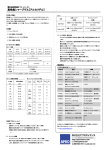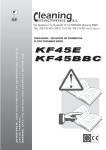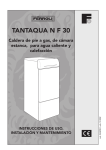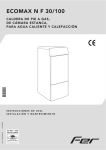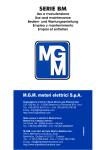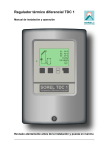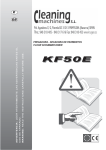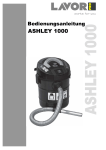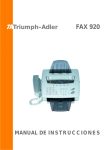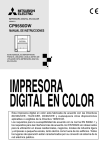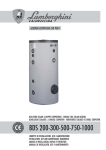Download Manual en PDF
Transcript
A D V E R T E N C I A : L E E R AT E N TA M E N T E L A S A D V E R T E N C I A S A N T E S E L U S O D E A PA R A D O . WA R N I N G : R E A D T H E I N S T R U C T I O N S C A R E F U L LY B E F O R E U S E . E GB FREGADORA - SECADORA DE PAVIMENTOS FLOOR SCRUBBER DRIER KF36E KF36BBC 2 FOTOGRAFIAS PHOTOGRAPHS PAG. 3 E ESPAÑOL PAG. 6 GB ENGLISH PAG. 12 A 1 2 2 3 4 5 B 1 2 3 5 4 3 C D 5 1 2 4 3 4 E 1 2 5 INTRODUCCIÓN 1. PREFACIO El presente manual ha sido redactado por el fabricante y forma parte integrante del producto, y como tal debe conservarse con cuidado durante toda la vida de la máquina hasta su demolición. La máquina descripta en el presente manual es una fregadora-secadora de suelos: debe utilizarse para la limpieza y aspiración de líquidos de suelos planos, rígidos, horizontales, lisos o poco rugosos, uniformes y sin obstáculos, en locales tanto civiles como industriales. Está prohibido cualquier otro uso que no sea los arriba indicados. Le rogamos lea detenidamente las informaciones sobre la seguridad proporcionadas en este manual. 2. TERMINOLOGÍA Para una mayor claridad y para evidenciar de modo adecuado los diferentes aspectos de las instrucciones descritas, se han utilizado los términos y símbolos que se definen y presentan a continuación: - Máquina. Esta definición sustituye el nombre comercial al que se refiere este manual. - Operario. Por operario se entienden las personas que normalmente utilizan la máquina y que conocen su funcionamiento, pero que no tienen conocimientos técnicos específicos para poder realizar las intervenciones que pudieran ser necesarias. - Técnico. Por técnico se entienden las personas con la experiencia, preparación técnica y conocimientos legislativos y normativos necesarios para permitir realizar todo tipo de intervención en la máquina, con la capacidad de reconocer y evitar posibles peligros durante la instalación, el uso, el desplazamiento y el mantenimiento de la máquina. 3. ADVERTENCIAS GENERALES Antes de usar la máquina fregadora es preciso conocer las normas presentadas en este folleto de instrucciones. En particular es importante que los encargados, los operadores y los responsables tengan conocimiento de las normas de seguridad para el uso de la máquina. El constructor, no podrá ser considerado responsable de inconvenientes, roturas, accidentes o cuanto otro debido a la ignorancia o a la herrada aplicación de las prescripciones presentadas en este manual. De la misma manera el constructor no podrá ser 6 considerada responsable de cara a roturas, accidentes o daños causados por modificaciones y variantes aportadas a las herramientas de la máquina sin previa autorización por escrito en tal sentido; como consecuencia de dichas modificaciones no autorizadas también cesan tanto la garantía que ampara al aparato como la declaración de Conformidad CE. El constructor se reserva el derecho de modificar la máquina, por cualquier exigencia de carácter constructivo o comercial, sin compromiso de actualizar tempestivamente el manual de instrucciones. NORMAS DE SEGURIDAD 1. ADVERTENCIAS GENERALES Las máquinas fregadora están construidas conformemente a la Directiva Comunitaria 89/392/CEE sobre las máquinas y sus sucesivas modificaciones. Es deber del responsable de la máquina atenerse a las normas comunitarias y gubernamentales que tienen por objeto la seguridad en los puestos de trabajo y capacitar a los operadores sobre las normas de seguridad y prevención de accidentes, las normas específicas correspondientes a las máquinas y la posición en las máquinas de los pulsadores de emergencia o de otros mecanismos con las mismas funciones. 2. USO DE LA FREGADORA Antes de poner en servicio la máquina, es preciso efectuar siempre las comprobaciones preliminares. En particular tiene suma importancia comprobar que las protecciones, fijas o móviles, estén en su sitio, correctamente aseguradas y en perfectas condiciones. Si debido a la necesidad de efectuar operaciones de mantenimiento de la máquina o por cualquier otro motivo es preciso retirar los cárteres de protección, es obligatorio restablecer su eficiencia antes de poner en marcha la máquina. Sólo operadores habilitados pueden utilizar la máquina; para impedir que la máquina sea utilizada por personal no autorizado y para impedir movimientos involuntarios cuando no trabaja, es preciso bloquear su funcionamiento. Se puede utilizar la máquina sólo si está en condiciones técnicas perfectas y conformes con su uso previsto como lava-seca; se prohibe cualquier otra clase de uso distinto del previsto por la casa constructora, como por ejemplo la tracción. El constructor no asume ninguna responsabilidad de cara a los daños que pueden derivarse de ello y que son totalmente a cargo del usuario. Antes de empezar a trabajar con la máquina, es preciso comprobar la eventual presencia de defectos visibles en los dispositivos de seguridad así como el funcionamiento correcto del botón de parada de emergencia o del mecanismo equivalente. Comprobar que: · En la máquina no haya objetos extraños (herramientas, trapos, etc.); · La máquina después del encendido no emita ruidos anómalos: de ser así pararla inmediatamente y averiguar la causa; · Estén bien cerradas todas las protecciones y las ventanillas. necesario abstenerse de cualquier modo de empleo que pueda perjudicar la estabilidad de la máquina. En particular: · No recorrer pendientes en dirección transversal · Cuando se recorren bajadas, la velocidad de marcha debe ser reducida con relación a la pendiente; · No girar la máquina a velocidad excesiva, especialmente en caso de pavimento no perfectamente horizontal. ¡IMPORTANTE! Se prohibe terminantemente aspirar líquidos y polvos inflamables y/o tóxicos. ¡ATENCION! No llenar el depósito de la solución con agua a temperatura superior a los 55°C. 3. NORMAS PARA EL MANTENIMIENTO Es peligroso, por lo que se prohibe terminantemente, tocar con las manos la parte inferior de la máquina cuando está en marcha. Para cualquier operación de mantenimiento, revisión o reparación, utilizar personal especialista o dirigirse a un centro de asistencia autorizado. Las operaciones sobre la instalación eléctrica pueden ser efectuadas sólo por parte de electricistas especialistas que conozcan las características técnicas de la máquina y las normas de prevención de accidentes. Usar exclusivamente fusibles originales que tengan las características técnicas prescritas. Es preciso inspeccionar y examinar periódicamente la instalación eléctrica; eventuales defectos, como por ejemplo conexiones flojas o cables dañados, deben ser restablecidos inmediatamente. · ¡IMPORTANTE! El líquido de las baterías es corrosivo y los gases son explosivos. · Durante la carga de las baterías Pb Acido es preciso dejar abierto el capó protector. · No usar llamas libres y no fumar cerca de las baterías. · No generar chispas cerca de las baterías. · No provocar cortocircuitos. · Respetar siempre la polaridad. Para las operaciones de limpieza y lavado de la máquina usar con cautela detergentes agresivos, ácidos u otros productos que puedan estropearla. Atenerse a las instrucciones del fabricante del detergente. Para la eliminación del líquido procedente del depósito de recuperación atenerse a las normas locales en materia de eliminación de desechos. Antes de empezar a trabajar, es preciso inspeccionar detenidamente el sitio en el cual vaya a ser utilizada a fin de comprobar la presencia de eventuales obstáculos. Durante el uso de la lava-pavimentos es preciso mantener siempre una distancia de seguridad con respecto a los bordes de las aceras o de cualquier otro desnivel del pavimento desde el cual la máquina pueda caer. Como regla general es 7 USO DE LA MÁQUINA DESCRIPCIÓN DE LOS COMANDOS Foto A 1) Interruptor general 2) Interruptor del motor de aspiración 3) Interruptor del motor del cepillo 4) Cepillo e solucion funcionamento 5) Cuentahoras (depende de la maquina) Foto B 1) Palanca de dosificación de la solución limpiadora 2) Tapón de ispección del depósito del agua sucia 3) Palanca de elevacion / bajada de la boquilla de secado 4) Tubo de vaciado del agua sucia 5) Tapon de llenado del deposito de la solucion Foto C Diagrama de conexion de las baterías Foto D 1) Hueco baterias 2) Parada de emergencia 3) Clavija del cargador de baterias 4) Control de bateria Foto E 1) Conexion de la boquilla de secado 2) Tornillo por la sostitucion de las hojas de la boquilla de secado 1. OPERACIONES PRELIMINARES Cuando se retira la máquina del embalaje se aconseja tener cuidado para no estropearlo; es posible usar de nuevo el embalaje para eventuales desplazamientos a larga distancia de la máquina. Comprobar inmediatamente el estado de la máquina y, si presenta desperfectos debidos al transporte, dar parte de ello inmediatamente al transportista. 1.1 PREPARACIÓN DE LA MAQUINA Las maquinas fregadora electrica y con las baterías OPTIMA se puede usar inmediatamente. Las maquinas fregadora sin baterías, esta necesario instalar las baterías, y configurar el cargador de baterías. 2. INSTALACIÓN DE LAS BATERÍAS Por instalar las baterias en el alojamiento: Instalar las baterías en el alojamiento correspondiente comprobando detenidamente que estén en perfectas condiciones. No añadir electrolito si las baterías han sido utilizadas por una semana o más. Para efectuar los enlaces de las baterías, es preciso que las superficies de los bornes o elementos similares estén bien limpias; se aconseja aplicar una capa fina de grasa o vaselina en los bornes o sobre las conexiones. Efectuar la instalación y la carga de las baterías en un sitio 8 ventilado y seco, lejos de fuentes de calor y de sustancias corrosivas. Comprobar la correspondencia de los voltajes entre baterías y cargador de baterías. Proteger la red con un interruptor de tipo retrasado o con un fusible de carga superior al consumo máximo del cargador de baterías. Respetar las polaridades de la toma de batería. En la foto E se puede ver cómo debe ser efectuada la conexión correcta de las baterías. 2.1 CONFIGURACION DEL CARGADOR DE BATERÍAS Se aconseja la intervencion del sistema de asistencia. El cargador de la maquina este configurado por baterías OPTIMA. Si la maquina esta equipada con baterías otra esta necesario configurar los cargador: Controlar la posicion de los dipswitch: (Foto D-1-5) Batterie type Pb-Acide Gel Optima SW2 SW1 Dip1 Dip2 Dip1 OFF OFF OFF ON OFF ON ON OFF OFF Dip2 ON ON OFF 3 . ARRANQUE Y PREPARACIÓN DE LA MÁQUINA A) CON CARGADOR INTEGRADO. Usar el conector del cargador de baterías de la maquina B) SIN CARGADOR INTEGRADO. Enchufar el cargador con le conector par la carga de las baterías de la maquina. 4. LAVADO Antes de cada lavado, es preciso llenar el depósito de la solución con la cantidad correcta de agua y detergente de espuma frenada; el llenado del depósito se realiza por la ventanilla correspondiente situada en la parte delantera. Los depósitos, de solución y de recuperación, están realizados en polietileno, material no atacable por ácidos y bases y por la mayor parte de los solventes. Para una buena limpieza del pavimento es preciso utilizar un detergente adecuado (de espuma frenada) para la superficie a limpiar y el tipo de suciedad. En caso de necesidad, pedir consejos al proveedor o a personas competentes, teniendo presente que un detergente demasiado agresivo puede ser perjudicial para la duración de la máquina. De todas maneras es necesario utilizar un detergente de espuma frenada o un aditivo anti-espuma, a fin de evitar daños al motor de aspiración. Para efectuar el lavado es necesario maniobrar el interruptor de encendido del motor del cepillo, bajar el cepillo apretando la palanca y abrir el grifo para la salida del agua.. La dosificación del agua debe ser tal que la superficie a limpiar quede bien mojada, sin salpicar, crear chorros o reboses por la boquilla de secado. Es preciso bajar la boquilla de secado maniobrando la palanca correspondiente en el momento de la puesta en marcha de la máquina y es preciso encender el motor de aspiración mediante el interruptor situado en el panel de comando. Recuerde que hay que levantar el squeegee antes de retroceder, a fin de evitar averías al squeegee. En el caso de que el pavimento estuviera muy sucio puede ser necesario efectuar un doble lavado. En la primera fase será efectuada una pasada con rl cepillo bajado, pero sin aspirar el líquido mediante la boquilla de secado; la solución detergente será dejada en el pavimento por el tiempo necesario para disolver la suciedad, que será recogida mediante un segundo paso de la máquina. Naturalmente esta segunda acción de limpieza será efectuada con el cepillo bajado, en marcha, con la boquilla de secado en contacto con el pavimento y con el aspirador encendido. Terminada la operación de lavado y secado del pavimento. Como última operación es preciso apagar los motores. Al final del lavado es preciso vaciar el depósito de recuperación del agua sucia mediante el tubo de desagüe. Es buena norma limpiar perfectamente el depósito de recuperación una vez terminado el trabajo. 5. REGULACIÓN DE LA BOQUILLA DE SECADO Para un secado perfecto del pavimento tiene suma importancia que la boquilla de secado esté perfectamente regulado. La presión correcta se alcanza cuando el canto de la hoja trasera toca el pavimento con una inclinación de 60/45° aproximadamente; si la presión es excesiva la hoja trasera toca el suelo con la superficie lateral y no con el canto; si es escasa el canto no trabaja bien y pierde agua dejando en el pavimento charcos de humedad. La mejor regulación de la boquilla de secado es la que proporciona un perfecto secado del pavimento y podrá ser necesario efectuar varios intentos. Por otra parte cabe recordar que a menudo el secado puede quedar afectado por un mal funcionamiento del equipo de aspiración. Si se presentara este inconveniente es necesario: - Limpiar perfectamente las tuberías de aspiración, las entradas y el propio la boquilla de secado - Comprobar el funcionamiento del motor de aspiración - Comprobar que la apertura de inspección del depósito esté bien cerrada. - Limpiar perfectamente el filtro del motor de aspiración. los dos sentidos hasta cuando se cae. Para introducir el cepillo nuevo, hay que colocarlo debajo del acoplamiento macho presente en la máquina, bajar el plato de el cepillo y encender el motor de el cepillo. NORMAS ESPECÍFICAS DE USO DEL MODELO ELECTRICO La máquina se puede poner en servicio sólo si la tensión (voltaje) indicada en la placa de características se corresponde con la disponible en el edificio y si la toma de corriente dispone de puesta a tierra. No perjudicar el cable de alimentación, no aplastarlo ni desgarrarlo. No pasar con la máquina por encima del cable de alimentación. El cable podría enrollarse en los órganos en movimiento causando un cortocircuito. ¡ATENCIÓN! - El modelo tiene partes bajo tensión o por las que circula corriente; el contacto con dichas partes puede causar graves lesiones y hasta la muerte. - Antes de efectuar cualquier operación en la máquina es preciso desconectarla de la red eléctrica. - No tocar nunca los cables eléctricos estropeados o que presenten signos de desgaste. - Antes de acceder a la instalación eléctrica es preciso apagar la máquina y desconectarla de la toma de corriente. - Si se notan cables eléctricos estropeados, reemplazarlos inmediatamente por repuestos originales. - Las conexiones con la red han de estar protegidas por lo menos contra las salpicaduras de agua. - No se permite en absoluto emplear cables de alargo para conectar la máquina con la red eléctrica. - La toma de corriente en la cual se enchufa la máquina ha de disponer de interruptor salvavidas. - Se prohibe terminantemente emplear la máquina cerca de piscinas o contenedores de agua SITUACIONES DE EMERGENCIA En casos de emergencia: - Desconectar inmediatamente la máquina de la red eléctrica - Aplicar inmediatamente las medidas de primeros auxilios En caso de accidente no se puede poner de nuevo en servicio la máquina sin que primero haya sido examinada por el personal especialista autorizado por el constructor. 6. SUSTITUCIÓN DEL CEPILLO Para sustituir el cepillo es preciso girarlo en uno de 9 MANTENIMIENTO ¡ AT E N C I Ó N ! - C u a l q u i e r o p e r a c i ó n d e mantenimiento o de reparación, no descrita en el mantenimiento ordinario, debe ser encargada a personal especialista autorizado por el constructor. 1. PLAN DE MANTENIMIENTO · A DIARIO Limpiar el depósito de recuperación Comprobar la limpieza de las tuberías de aspiración y de la boquilla de secado Comprobar el filtro del motor de aspiración · SEMANALMENTE Comprobar el estado del cepillo Comprobar el estado de las hojas de goma de la boquilla de secado Comprobar el motor de aspiración · MENSUALMENTE Comprobar el estado de la válvula de alimentación de la solución de lavado 2. BATERÍAS Pb ÁCIDO · CONTROL DEL ESTADO DE CARGA DE LAS BATERÍAS Dado que se sabe que hay una relación directa entre el peso específico del electrolito y el estado de carga de la batería, se toma la medida del peso específico del electrolito como control correcto y eficaz del estado de carga de la batería. Cuando la batería está cargada y en condiciones normales, con el electrolito al nivel correcto, la densidad del electrolito será aproximadamente de 1,260 kg/lt (30° Be) referida a 30°. Si por el contrario la densidad está incluida entre 1,26 kg/lt (30° Be) y 1,20 kg/lt (24° Be) la batería está parcialmente descargada, mientras que si la densidad es inferior a 1,14 kg/lt(18° Be) la batería está completamente agotada. · MEDIDA DE LA DENSIDAD La medida de la densidad del electrolito es la comprobación más importante de una batería. Esta medición debe ser efectuada con la máxima atención utilizando el densímetro. Se introduce el densímetro de jeringa y se saca una cantidad de electrolito suficiente para poner a flote el flotador. Tener cuidado en que su cumbre no toque la pera en goma y en que no quede pegado, por capilaridad, a las paredes de vidrio. Si se debe efectuar la medición de la densidad después de haber agregado agua destilada, es preciso esperar que la densidad se haya vuelto homogénea en todo el liquido contenido en el elemento. · RELLENADO DE AGUA Añadir agua destilada en cada celda de las baterías después de haber cargado las baterías para llevar el líquido al nivel de 6 mm. por encima de las placas. 10 La operación al principio será efectuada después de cada carga, más adelante los rellenos podrán efectuarse con menor frecuencia, según la experiencia del encargado, pero no se debe nunca sobrepasar la semana entre un relleno y el sucesivo. · LÍMITES DE CARGA No es necesario recargar la batería si la densidad, al final de la jornada laboral, no ha descendido por debajo de 1,24 kg/lt (28° Be). El abuso más frecuente notado en el uso de las baterías para tracción es la sobrecarga. Este factor por sí mismo, si es continuo, puede acortar drásticamente la duración de las baterías. La temperatura máxima recomendada es de 45 °C; si la temperatura del electrolito sube más allá de 10/12 °C con respecto a la temperatura ambiente, se puede producir la sobrecarga independientemente de la temperatura efectiva alcanzada. · SITIOS DONDE CARGAR LAS BATERÍAS Los gases que se desarrollan durante la operación de carga presentan riesgo de explosión; por lo tanto es preciso asegurar una buena ventilación de la batería durante la operación de carga y unas conexiones seguras en los bornes para evitar eventuales chispas. Los sitios donde se realiza la carga de las baterías deben estar bien ventilados y no deben alcanzar temperaturas superiores a los 40/45 °C. Si, mediante las ventanas no hay una ventilación suficiente es preciso prever adecuados conductos de escape que, de ninguna manera, deben ir a parar a las chimeneas. A ser preciso hay que usar ventiladores para hacer más rápido el cambio de aire. · BATERÍAS NO EN SERVICIO CONTINUO O INACTIVAS - Pb ACIDO Y GELDurante los periodos de inactividad, las baterías se agotan espontáneamente (autodescarga). La autodescarga quita diariamente a la batería parte de su carga y causa también una sulfatación de las placas que progresa con el pasar del tiempo, perjudicando la eficiencia de la propia batería. Si no se utiliza la batería de manera continua, es preciso someterla a una carga de mantenimiento por lo menos una vez al mes. Es preciso efectuar esta operación también cuando la medida del peso específico proporciona valores altos. Si la batería queda inactiva por largos periodos de tiempo, es preciso guardarla en un sitio fresco y seco. Una vez al mes es preciso cargarla, con la intensidad de corriente indicada como final, hasta cuando se nota, en todos los elementos, un gran desarrollo de gas y hasta cuando las lecturas de voltaje y de peso específico quedan constantes durante 3-4 horas. En todo caso, antes de poner de nuevo en servicio una batería que haya quedado inactiva por mucho tiempo, es preciso cargarla y comprobar que tenga un nivel electrolítico correcto. 3. SUSTITUCIÓN DE LAS HOJAS DE LA BOQUILLA DE SECADO Es preciso sustituir las hojas de la boquilla de secado cuando el canto de contacto resulta estar desgastado; la perfección del canto es efectivamente fundamental para conseguir un secado perfecto. Para sustituir las hojas de la boquilla de secado es preciso desmontarlo de la máquina. Para desmontarlo es preciso llevar el soporte de la boquilla de secado en posición alta, seguidamente retirar de la boquilla de secado el tubo de aspiración y luego retirar los botones. Ahora es posible retirar la boquilla de secado de la máquina y colocarla sobre un banco de trabajo; ahora es preciso aflojar los botones y bajar el apojo plastico. Efectuar después la operación inversa y montar las hojas nuevas y seguidamente proceder a la regulación de la boquilla de secado. 11 Moreover, the guarantee covering the appliance will no longer be valid if such unauthorised changes are made. The manufacturer reserves the right to make modifications to the machine, for any construction or commercial requirement, without being obliged to update the instruction manual in time. INTRODUCTION 1. PREFACE This manual has been prepared by the manufacturer and is an integral part of the product. As such, it must be kept in a safe place for the machines entire service life until demolition. This machine is a floor scrubber-drier: it must be used to scrub and to vacuum liquids of flat, rigid, horizontal, smooth or moderately rough and uniform floors that are free from obstacles in both civic and industrial environments. Any other use is prohibited. Please refer very carefully to the safety information reported in this manual. 2. TERMINOLOGY For the sake of clarity and to efficiently highlight the various aspects of the instructions provided, terms and symbols were used that are defined and illustrated here below: - Machine. This definition replaces the commercial name to which this manual refers. - Operator. An operator is considered the person who normally uses the machine and is familiar with its operating features but does not have the specific technical skills to work on that machine. - Technician. A technician is considered a person who has the experience, technical education, legislative and regulatory knowledge that allows him to carry out any type of required work, and the ability to recognize and to avoid possible risks during machine installation, operation, handling and maintenance. 3. GENERAL WARNINGS It is important to carefully read the contents of this manual before using the machine and it is especially important for those who use the machine, operators, and supervisors, to be well-acquainted with the safety regulations for its use. The manufacturer cannot be held responsible for any mishap, breakdown, accident or any other event resulting from the ignorance, incorrect application or lack of application, of the instructions given in this manual. Likewise, the manufacturer will not accept any responsibility for breakdown, accident or damage caused by changes or variations made to the machine by the users without previously obtaining the written authorisation from the manufacturer. 12 SAFETY REGULATIONS especially if the floor is not perfectly horizontal. 1. GENERAL WARNINGS IMPORTANT! It is absolutely forbidden to suck up inflammable and/or toxic liquids and powders. This floor scrubbers have been manufactured in accordance with the Community Directive 89/392/EEC on machines and further modifications to it. The person in charge of the machine is responsible for conforming to the community and state norms regarding safety on work sites and for training operators on safety and accident-prevention regulations, on the specific norms relating to the machines and on the position of emergency buttons or mechanisms which have the same function. 2. USING THE MACHINE Always make the preliminary checks on the machine before starting it up. It is particularly important to check that the fixed or removable protections are in position, correctly secured and in perfect condition. If for the maintenance of the machine or for any other reason, the protective coverings should be removed, they must be return to their original position before starting up the machine. The machine can be used only by qualified operators and to prevent the machine from being used by unauthorised people and to block accidental movements when it is not operating, the operation must be locked. The machine must be used only if it is in perfect condition and if it is to be used for its specific purpose as scrubber, any other use that goes beyond that provided for by the manufacturer, such as traction, is forbidden. The manufacturer cannot be held responsible for any damage resulting from incorrect use, which is the complete responsibility of the user. Before starting the job, check that there are no visible defects in the safety devices and the regular functioning of the emergency stop button or equivalent mechanism. Check that: · There are no foreign objects on the machine (utensils, rags, etc.); · After the machine has been turned on, it does not make any strange noise. If it does, stop it immediately and look for the cause; · All the protections and doors are closed properly. CAUTION!!: Do not fill the solution tank with water hotter than 55°C 3. MAINTENANCE RULES It is dangerous and therefore absolutely forbidden to touch the lower part of the machine with the hands while it is working. Use specialised personnel or contact an authorised service centre for any maintenance, revision or repair job. Only specialised electricians, who are familiar with the technical characteristics of the machine and the accident-prevention regulations, can carry out jobs on the electrical circuit. Use only original fuses, which have the prescribed technical characteristics. The electric circuit must be inspected and examined periodically and any defects found, such as unstable connections or damaged cables, must be eliminated immediately. IMPORTANT! The liquid in the batteries is corrosive and the gases are explosive. · The protective hood must be left open while the batteries are being charged. · Do not use flames and do not smoke in the proximity of the batteries. ·Do not provoke sparks near the batteries. · Do not provoke short circuits. · Do not invert the polarity. During cleaning and machine washing operations, take care using aggressive detergents, acids, or other products that could damage the machine. Follow the manufacturer instructions regarding the detergent. To dispose of the liquid coming from the recovery tank follow the local regulations regarding waste disposal. The place in which the machine is to be used should be carefully checked before starting the job to see if there are any obstacles. While the scrubber is being used always keep a safe distance from the edges of footpaths or from any other floor at a different height from which the machine could fall. As a general rule, any way of using the machine that could prejudice its stability should be avoided. In particular: · Do not move across a slope; · When going down a slope, the speed of the machine must be reduced as the degree of the slope increases; · Do not turn the machine at an excessive speed, 13 USING THE MACHINE correct connection of the batteries CONTROL DESCRIPTION 2.1 CHARGER CONFIGURATION Photo A 1) General switch 2) Suction motor and detergent switch 3) Brush motor switch 4) Brush and detergent security switch 5) Hours counter (according to models) Photo B 1) Solution adjuster lever 2) Recovery tank inspection plug 3) Squeegee lift/lower lever 4) Recovery tank drain hose 5) Solution tank filler Photo C Battery connection diagram Photo D 1) Battery compartment 2) Emergency button / temporary interruption 3) Charger connection 4) Battery power indicator Photo E 1) Squeegee fixing screw 2) Bolt for squeegee blade replacement 1. PRELIMINARY OPERATIONS Be careful not to damage the packaging when the machine is unpacked it could be used again if the machine has to be transported over a long distance. Check the conditions of the machine immediately and if it has been damaged during the transportation, immediately notify the transport company. 1.1 PREPARING THE MACHINE Electric and with gel battery included machine are ready to use. Machine without battery must be equipped of battery, charger and circuit board must be configurated. 2. INSTALLATION OF THE BATTERIES To insert batteries its necessary: Install the batteries in their specific place (Photo D - 1), carefully checking that they are in perfect condition.To make the battery connections, the surfaces they come into contact with have to be accurately cleaned. It is advisable to apply a fine layer of grease or Vaseline to the terminals or the connections. Install and charge the batteries in a dry ventilated place, far from sources of heat and corrosive substances. Make sure that the voltage between the batteries and the battery charger corresponds. Protect the circuit with a delay switch or a fuse with a higher charge than the maximum absorption of the battery charger. Comply with the polarity of the battery plug. Photo C shows the 14 We recommend calling the assistance centre or a technician if you have problems with the setting given. The machine is equipped to Optima battery type charter configurated. If the operator desire use different battery, its necessary verify dip switch position (Photo D - 1-5): Battery type Pb-Acido Gel Optima SW2 SW1 Dip1 Dip2 Dip1 Dip2 OFF ON ON ON OFF OFF OFF ON OFF ON OFF OFF 3. STARTING UP AND PREPARING THE MACHINE A) WITH INTEGRATED BATTERY-CHARGER. Use the battery-charger plug on the machine. B) WITHOUT INTEGRATED BATTERY-CHARGER. Connect the battery-charger plug to the socket on the machine. 4. WASHING Before every wash, the solution tank has to be filled with the correct quantity of water and low-foam detergent. The tank is filled through the special hatch at the front of the machine. The solution and recovery tanks are made in polythene, resistant to acids and basics and to the majority of solvents. To clean the floor well it is necessary to use a detergent (low foam) suitable for the surface to be cleaned and the type of dirt. If necessary, contact the supplier or a competent person, remembering that a detergent that is too aggressive can be damaging for the long life of the machine. It is necessary, therefore, to use a low foam detergent or a non-foam additive to prevent the suction motor from being damaged. To start the wash, turn on the ignition switch of the brush motor and open the tap to let water come out. The dose of the water should be such that the surface to be cleaned is quite wet, without however causing splashes, trickles or overflow from the squeegee. The squeegee must be lowered using the lever when the machine is started up, and the suction motor must be turned on with the switch on the control panel. Remember to lift the floor cleaner before reversing to avoid damaging it. If the floor is very dirty, it may need to be washed twice. In the first stage the brush will be lowered, but without the liquid being sucked by the squeegee. The detergent solution will be left on the floor for the time necessary to dissolve the dirt, and then collected when the machine goes over a second time. This second stage will be done with the brush lowered and the squeegee touching the floor. When the washing and drying operation has finished. The last operation is to turn off the motors. When the washing operation has finished, the recovery tank has to be emptied of the dirty water through the outlet tube. It is a good rule to thoroughly clean the recovery tank once a week. 5. REGULATION OF THE SQUEEGEE The squeegee has to be regulated to perfection to dry the floor perfectly. The correct pressure is reached when the edge of the back blade touches the floor with an inclination of approximately 60/45°. If the pressure is too high the back blade touches the floor with the side surface and not with the edge, if it is too low the edge does not work well and leaks water, leaving damp puddles on the floor. The perfect drying of the floor will indicate the right regulation of the squeegee and perhaps it will be necessary to try several times before reaching this point. It is important however to remember that often the drying is influenced by the bad functioning of the suction plant. If this should happen, it is necessary to: · Thoroughly clean the suction tubes, the inlets and the squeegee itself. · Check the functioning of the suction motor. · Check that the inspection opening of the tank is tightly closed. · Clean perfectly the suction motor filter. 6. REPLACING THE BRUSHES Rotate the brush in one of the two directions until it falls off. To insert the new brush, place it under the male joint on the machine, put the brushes support down and turn on the brushes motor. INSTRUCTIONS FOR ELECTRIC MODEL USE The electric machine may be turned on only if the voltage indicated on the tag corresponds with the available voltage and that the electrical outlet is grounded (earthed). Do not damage the feed cable; do not crush or pull on it. Do not run over the feed cable with the machine. The cable could wind up in moving parts causing a short circuit. ATTENTION !!! - The electric machine has parts, which are connected to the current; contact with these could cause grave injuries or even death. · Before executing any type of operation on the machine always disconnect it from the electrical source. · Never touch electric cables that are defective or worn. · Before gaining access to the electrical system it is always necessary to disconnect the machine from the electrical source. · In the case of defective, damaged, or cracked electric cables, replace immediately with authentic replacement parts. · The network of connections must be protected from water spray. · Use of extension cords for the machines network connections is not allowed in any case. · The electrical system to which the machine is connected must be equipped with a cut-out box. · It is absolutely forbidden to use the machine in proximity to swimming pools or stretches of water. EMERGENCY SITUATIONS In case of emergency: · Immediately disconnect the machine from the electrical source. · Immediately apply proper first-aid. If an accident should occur the machine must not be put into operation until a technician authorised by the manufacturer has examined it. MAINTENANCE ATTENTION! Every maintenance or repair intervention that is not described in the following pages must be carried out by specialised personnel, authorised by the manufacturer. 1. MAINTENANCE PROGRAM - DAILY Clean the recovery tank. Check the cleanliness of the suction hose and of the squeegee. Check the suction filter - WEEKLY Check the condition of the brushes. Check the condition of the rubber blades of the squeegee. Check the suction motor. - MONTHLY Check the conditions of the washing solution inlet valve. - EVERY SIX MONTHS Check the conditions of the carbon plates for every motor. 2. Pb ACID BATTERIES - CHECKING THE BATTERY CHARGE As it is a known fact that there is a direct relationship between the specific weight of the electrolyte and the state of the battery charge, the measurement of the specific weight of the electrolyte is taken as an effective correct control of the state of the battery charge. When the battery is charged and in normal conditions, with the electrolyte at the right level, the density of the electrolyte will be about 1.260 kg/lt (30° Bè) referred to 30°. If instead the density is 15 between 1.26 kg/lt (30° Bè) and 1.20 kg/lt (24° Bè) the battery is not fully charged, while if the density is lower that 1.14 kg/lt (18° Bè) the battery is completely flat. - MEASURING THE DENSITY The measurement of the electrolyte density is the most import check made on a battery. Therefore, it must be made with the utmost attention with a densimeter. Insert the syringe densimeter and take just enough electrolyte to bring the float to the surface. Make sure that the top of it does not touch the rubber pear or that it does not remain stuck with capillarity to the glass sides. Measure the density after adding distilled water and wait for the density to become homogeneous throughout the liquid contained in the element. - REPLENISHING THE WATER Add distilled water to every single cell of the battery after having loaded the batteries to bring the level of the water 6 mm above the plates. At the beginning, this operation will have to be repeated after every charge, but from then on it can be done less frequently, according to the supervisors experience, but never going over a week between one replenishment and the next. - CHARGE LIMITS It is not necessary to recharge the battery if, at the end of a day of work, the density has not gone below 1.24 kg/lt (28° Bè). The most common misuse found in batteries for traction is overcharging. This factor on its own, if done continuously, can drastically shorten the life of the batteries. The maximum recommended temperature is 45°C, if the temperature of the electrolyte increases by over 10/12°C compared to the environmental temperature, overcharging can come about independently from the actual temperature reached. - ROOMS FOR CHARGING THE BATTERIES The gases that develop during the recharging operation can cause explosions, therefore the battery has to be in a well-ventilated place during the recharging operation and the contacts with the terminals have to be safe so that sparks are not created. The rooms in which the batteries are recharged haveto be well-ventilated and the temperature must not exceed 40/45°C. If there is not enough aeration through the windows special discharge flues must be provided, but they must not lead off into chimneys. When it is necessary, the change of air must be made more rapid with the use of ventilators. - INACTIVE OR TEMPORARILY OUT OF SERVICE BATTERIES - Pb ACID AND GEL16 The batteries discharge spontaneously (selfdischarge) during periods of inactivity. With this selfdischarge the battery loses a part of its charge every day and also causes sulphation of the plates which increases in time, to the detriment of the efficiency of the battery. If the battery is not used continually, it has to be re-charged at least once a month. In any case, before putting a battery back into use after it has been inactive for a long time, it has to be recharged. 3. REPLACEMENT OF THE SQUEEGEE BLADES The squeegee blades have to be replaced when the contact edge is abraded; in fact the integrity and perfection of the edge is essential for perfect drying. To replace the blades, the squeegee has to be disassembled. Bring the squeegee support to the high position, remove the suction tube from the squeegee and remove the knobs. Now it is possible to remove the squeegee from the machine and place it on a bench. Unscrew the knobs and remove plastic support. Carry out the same procedure on the contrary to assemble the new blades, then adjust the squeegee. CE DECLARATION OF CONFORMITY The manufacturer DECLARES UNDER ITS RESPONSIBILITY THAT THE MACHINE Brand Type KF 36E KF 36BBC as described in the annexed documentation, conforms to EEC Machine Directive 98/37, Electromagnetic Compatibility Directive EEC 2004/108 and Low-voltage Directive EEC 2006/95. Pamplona, 24/05/2008 DECLARACIÓN CE DE CONFORMIDAD El fabricante DECLARA BAJO SU EXCLUSIVA RESPONSABILIDAD QUE LA MÁQUINA Marca Tipo KF 36E KF 36BBC Come se describe en la documentación adjunta, es conforme a la Directiva Máquinas CEE 98/37, Directiva Compatibilidad Electromagnética CEE 2004/108 y Directiva BajaTensión CEE 2006/95 . Pamplona, 24/05/2008 Condiciones de garantía Todos nuestros aparatos han sido sometidos a pruebas severas y están cubiertos por una garantía de 12 meses por defectos de los materiales o de fabricación. La garantía tiene validez a partir de la fecha de compra. La fecha de compra es aquella indicada en el recibo que el Revendedor da al cliente en el momento de la entrega del aparato. El constructor se compromete a reparar o sustituir gratuitamente las partes que dentro del período de garantía se presenten con defectos de fabricación. Defectos no claramente atribuidos al material o a la fabricación serán examinados en uno de nuestros Centros de Asistencia Técnica o en nuestra sede, y adeudados según los resultados. Están exluidos de la garantía: los daños accidentales, por transporte, por descuido o tratamiento no adecuado, por uso e instalación impropios o errados, no conformes con las advertencias indicadas en el manual de instrucciones, y también por causas no dependientes de la norma y del funcionamiento o uso del aparato. La máquina que se debe reparar se entregará al centro de asistencia con todos sus accesorios originales junto con el documento comprobante de la compra; la garantía no tiene validez cuando el aparato ha sido reparado o alterado por terceras personas no autorizadas; la incapacidad de entregar el documento de compra original (legible y completo) de parte del utilizador o la imposibilidad de recuperar los números de matrícula de la máquina escritos en el chasis también anularán la garantía. Está excluida la sustitución del aparato y el alargamiento de la garantía después de la reparación de un daño. Dicha reparación se efectuará en uno de nuestros Centros de Asistencia Técnica o en nuestra sede, y debe llegar en puerto franco, es decir, con gastos y responsabilidad por el transporte a cargo del utilizador. La garantía no incluye la limpieza de los órganos de funcionamiento, todas las tareas de mantenimiento periódico, la reparación o sustitución de las partes sujetas a un normal desgaste. El constructor no se hace responsable de los eventuales daños a personas o cosas causados por una instalación no conforme con las indicaciones del manual o por un uso imperfecto del aparato. Conditions of Warranty All our appliances are subjected to rigorous tests and are covered by warranty against material or manufacturing defects for a period of 12 months. The warranty comes into effect from the date of purchase. The date of purchase is the date indicated on the receipt issued by the Reseller when the appliance is consigned. The manufacturer shall repair or replace any faulty parts free of charge during the period covered by the warranty. Any defects, which cannot be clearly attributed to material or manufacturing defects shall be examined by one of our Technical Service Centres or at our factory and charged in accordance with the outcome. The following are anyhow not covered by the warranty: accidental damage during transportation or handling, accidental damage caused by negligence or unsuitable conduct, damage due to incorrect or improper uses or installations which do not conform with the warnings included in the instruction manual, and anyhow due to unusual events which do not depend on the running or use of the appliance. Appliances requiring repair must be delivered at the Technical Service Centre complete with all their original accessories together with proof of purchase. If the appliance has been repaired or tampered with by unauthorised third parties, the warranty shall be considered null and void. The warranty shall also be considered null and void if the user is not able to produce an original (legible and complete) document proving purchase or if it not possible to read the appliance serial number located on the frame. The appliance shall not be replaced and the warranty shall not be extended once the appliance has been affected by a fault. Repairs shall be carried out at one of our Authorised technical Service Centres or at our factory. Appliances for repair must be sent carriage free, that is, the user shall pay and be responsible for carriage. The warranty does not cover the cleaning of working parts, any scheduled maintenance nor the repair or replacement of parts subject to normal wear and tear. The manufacturer shall not be held liable for damage to persons or things caused by any installation which does not comply with the instructions in the manual or faulty use of the appliance. Italiano Quale proprietario di un apparecchio elettrico o elettronico, la legge (conformemente alla direttiva UE 2002/96/CE del 27 gennaio 2003 sui rifiuti di apparecchiature elettriche ed elettroniche e alle legislazioni nazionali degli Stati membri UE che hanno messo in atto tale direttiva) Le vieta di smaltire questo prodotto o i suoi accessori elettrici/elettronici come rifiuto domestico non separato. È tenuto invece a far uso dei previsti punti di raccolta gratuiti. English As owner of an electrical or electronic product, you are not allowed by law (according to EU-Directive 2002/96/EC of 27 January 2003 on waste electrical and electronic equipment and the particular national laws of the EUMember States transforming this Directive) to dispose of this product or its electrical/electronic accessories as unsorted domestic waste. You shall use the designated gratis possibilities for return instead. Français La législation (directive européenne 2002/96/CE du 27 janvier 2003 relative aux déchets d'équipements électriques et électroniques (DEEE) et législations nationales des états membres de l’UE reprenant celle-ci) interdit au propriétaire d’un appareil électrique ou électronique de jeter celui-ci ou ses composants et accessoires électriques/électroniques mélangés aux ordures ménagères. Veuillez remettre l’appareil usagé aux points de collecte gratuite indiqués. 27. Januar 2003 über Elektro- und ElektronikAltgeräte sowie gemäß nationalen Ländergesetzgebungen der EU-Mitgliedstaaten, in denen diese Richtlinie umgesetzt wird), dieses Produkt oder seine elektrischen/elektronischen Zubehörteile unsortiert in den Haushaltsmüll zu geben. Bitte benutzen Sie stattdessen die hierfür ausgewiesenen kostenlosen Rückgabe-Stellen. Español Como propietario de un aparato eléctrico o electrónico le está prohibido por ley (a tenor de la Directiva de la UE 2002/96/CE del 27 de enero de 2003 sobre residuos de aparatos eléctricos y electrónicos y la legislación nacional de los estados miembros de la UE que haya incorporado esta directiva) eliminar este producto o sus componentes eléctricos/electrónicos como residuos urbanos no seleccionados. Por favor, utilice en su lugar los puntos de recogida que sin cargo alguno se han establecido para este fin. Portuguese Como proprietário de um aparelho eléctrico ou electrónico, a lei proíbe-lhe (segundo o Directiva CEE 2002/96/CE de 27 de Janeiro de 2003 relativa a equipamentos eléctricos e electrónicos velhos, bem como segundo as legislações nacionais aplicáveis nos Estadosmembros da UE em que a referida directiva é transposta) deitar este produto ou os seus componentes eléctricos/electrónicos no lixo doméstico sem uma separação anterior. Por favor, use os pontos de devolução gratuita indicados para o efeito. Deutsch Als Besitzer eines elektrischen oder elektron- Polish ischen Gerätes ist es Ihnen gesetzlich unter- Zgodnie z regulacją UE 2002/96/EG z dnia 27 sagt (gemäß EU-Richtlinie 2002/96/EG vom stycznia 2003 r. o utylizacji zużytego sprzętu elektrycznego i elektronicznego oraz przepisami prawnymi obowiązującymi w danym państwie członkowskim Unii, usuwanie tego produktu i jego elektrycznych/elektronicznych akcesoriów wraz odpadami domowymi jest surowo zabronione. Jako właściciel takiego sprzętu jest Pan/Pani odpowiedzialny/a za prawidłową utylizację zużytych urządzeń, tzn. należy je zwrócić do odpowiednich bezpłatnych punktów zbiorczych. Hungarian Az elektromos vagy elektronikus készülékek tulajdonosainak törvény (az elektromos és elektronikus berendezések hulladékairól szóló, 2003. január 27-i 2002/96/EK európai uniós irányelv, valamint az ezt az irányelvet alkalmazó EU-tagállamok nemzeti törvényei) tiltja meg, hogy a szóban forgó termékeket vagy azoknak elektromos/elektronikus alkatrészeit osztályozatlanul a háztartási szemétbe juttassák. Kérjük, hogy ezeket a kijelölt díjmentes hulladékátvevő helyen adják le. Serbian Kao vlasniku električnog ili elektronskog proizvoda, zakonom vam nije dozvoljeno (u skladu sa EU direktivom 2002/96/EC od 27. januara 2003., o otpadu električne i elektronske opreme i posebnim nacionalnim zakonima zemalja članica EU koje su prihvatile tu direktivu) odlagati ovaj proizvod ili njegove električne/elektronske dodatke kao neodeljen kućni otpad. Morate naprotiv da koristite predviđene besplatne mogućnosti sakupljanja. Russian Вам как владельцу электрического или электронного прибора запрещено законом (в соответствии с директивой ЕС 2002/96/EG от 27 января 2003 г. о старых электрических и электронных приборах, а также в соответствии с национальным законодательством странычлена ЕС, в которое трансформируется эта директива), выбрасывать в бытовой мусор без сортировки этот продукт или его электрические/электронные компоненты. Пожалуйста, сдавайте эти приборы на соответствующие бесплатные пункты сбора. Czech Jako majiteli elektrického nebo elektronického přístroje vám zákon (podle směrnice Evropské unie 2002/96/ES ze dne 27. ledna 2003 o odpadních elektrických a elektronických zařízeních a podle národních právních předpisů členských států EU, ve kterých je tato směrnice aplikována) zakazuje, abyste tento výrobek nebo jeho elektrické resp. elektronické díly likvidovali jako neroztříděný domácí odpad. Používejte místo toho laskavě k likvidaci bezplatné sběrny, které jsou k tomu určené. Romanian În calitate de posesor al unui aparat electric sau electronic vă este interzis prin lege (conform directivei EU 2002/96/EG din data de 27 ianuarie 2003 privind aparatele electrice şi electronice uzate precum şi în conformitate cu legislaţia naţională a statelor membre ale UE în care directiva este valabilă), să aruncaţi acest produs sau componentele electrice/electronice ale acestuia odată cu deşeurile menajere. Vă rugăm să utilizaţi în schimb punctele gratuite de colectare special destinate acestor aparate. cod. 7.504.0164 01/2009
























